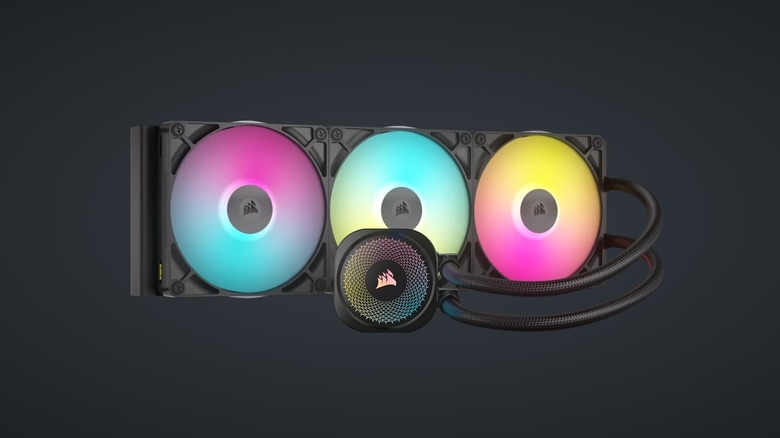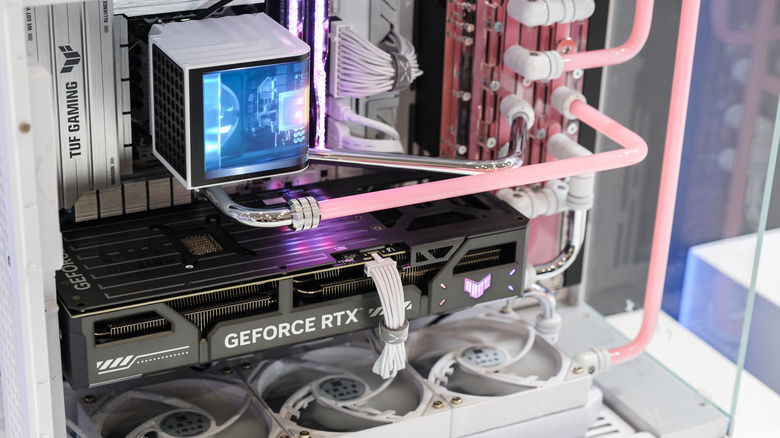Signs It's Time To Replace Your PC's AIO Cooler
All-in-one (AIO) liquid coolers are a great way to keep your PC temps nice and stable, but many aspiring PC builders are hesitant when building their first water-cooled PC. Many people think that AIO coolers require lots of maintenance or are dangerous to your PC because of the coolant inside their tubes. While it's true that liquids and electronics decidedly do not mix, AIO coolers are much less of a hassle than some people would have you believe, but like any PC component, their time eventually comes to an end, and you may start seeing telltale signs they need to be replaced.
Before we dive in, let me dispel a couple of common myths about liquid coolers. The misconceptions that they're difficult to set up, dangerous, or require a lot of maintenance stem from confusing two different types of water coolers: AIOs and custom loops. The difference between the two is that AIOs are pre-built for you. They come pre-assembled and consist of a closed-loop cooling system that only allows for minimal maintenance. Custom loops, however, are fully customizable and are built from individual components that you get to decide, including a pump, a reservoir, tubing, water blocks, and radiators. They typically offer better thermal performance, but can be a hassle to build and maintain; they're generally only reserved for enthusiasts.
When it comes to AIO coolers, it's a more straightforward matter: You can't easily replace the liquid or alter the tubing. You should still keep your PC clean, though, and that includes regularly removing dust from the radiator and the fans. While you're at it, remember to replace your thermal paste.
What are some signs it's time to replace your AIO?
Although AIO coolers are typically considered to be safe, like any PC component, they can fail eventually. The problem with AIOs is that if they do fail, it can be quite catastrophic, so it's important to keep an eye out for the tell-tale signs and act before anything ever gets close to total and complete failure.
Often, the first indicator that something is wrong will lie in your PC's cooling performance, which means that you can easily miss it unless you monitor temperatures on a regular basis. If you feel your PC running hotter than usual or struggling to carry out resource-heavy tasks, like gaming or video editing, temperatures are the first thing to look into. You might also notice frame rate drops or even crashes, and if your PC starts shutting down under heavy load, that's a huge warning sign. I recommend using a tool like HWiNFO or NZXT's CAM to monitor CPU temperature, but we also have a full guide to monitoring CPU temperature and fixing cooling issues.
The pump is the most likely part to fail in an AIO, and when it fails, it stops circulating coolant through the AIO loop, which often leads to a sudden spike in CPU temperature. You can check for this by touching the tubes — if they're not warm and you can't hear a slight hum, the pump is likely dead. Some motherboards might detect that the pump isn't working and will cause your PC to display an error.
Lastly, keep an eye (or rather, an ear) out for unusual noise. A healthy AIO may hum a little bit, but gurgling, bubbling, and grinding noises often mean that something is going wrong.
How long do AIO coolers typically last?
Many AIO coolers come with a warranty of around five years. Corsair offers six years on its iCUE Link models, five years on the majority of its product stack, and only three years on its Hydro RGB coolers. Many other popular AIO brands, such as Arctic, also max out at around six years. This is generally a solid indicator of how long you can expect your AIO to function properly, but the reality can often be different. Your AIO might fail at any given time, or it might function perfectly for over a decade, and there's no telling which way it will go before it actually ends up failing (or, more likely, not failing).
Despite the six-year warranty, many AIOs last longer than that. If you use your PC frequently and push your cooler to the limit, you might run into issues with it sooner, but some manufacturers estimate that their pumps will last for up to 70,000 hours, which is around eight years.
I've been building my own computers for nearly 20 years and have never had a catastrophic AIO failure happen to me or anyone that I know (let's hope it stays that way), so the fear of leaks is still quite exaggerated, I'd say. However, the pump might fail or the coolant might evaporate over time, especially after years of use. When that happens, your PC won't suddenly set itself on fire; instead, temps will rise steadily over time, alerting you that you should consider an upgrade. You can't replace the coolant in an AIO (at least not unless you're an expert), which is why you will probably have to replace the cooler itself one day, but you'll likely get a good few years out of it first.


